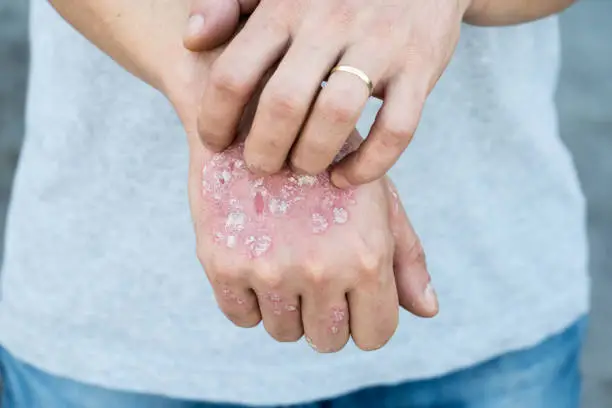Plaque psoriasis is a common skin condition that causes red, raised patches covered with silvery scales. It is a long-term autoimmune disorder where the body’s immune system attacks its own skin cells, leading to these thick, scaly rashes. The most important thing to know is that plaque psoriasis is treatable with different options like creams, light therapy, and medications.
This condition can affect any part of the body, but often shows up on the scalp, elbows, knees, and back. People with plaque psoriasis may feel uncomfortable or self-conscious because of the visible patches, but understanding the causes and treatments can help manage the symptoms.
Learning how plaque psoriasis works and what triggers it can make a big difference in living with the condition. Knowing the right treatments and lifestyle changes can reduce flare-ups and improve quality of life.
Understanding Plaque Psoriasis
Plaque psoriasis is a skin condition that causes thick, red patches covered with silvery scales. It happens because the immune system makes skin cells grow too fast. Many things can trigger or make symptoms worse, including stress and infections.
Definition and Symptoms
Plaque psoriasis is an autoimmune disease. This means the body’s immune system attacks healthy skin cells by mistake. It leads to red, raised patches called plaques. These plaques usually have silver-white scales on top.
Common places for plaques are the elbows, knees, scalp, and lower back. The patches can be itchy or sometimes hurt. People often have dry, cracked skin that may bleed.
Plaque psoriasis stays for a long time and can come and go. The condition affects about 80-90% of people who have psoriasis, making it the most common type.
Causes and Risk Factors
Plaque psoriasis starts because the immune system becomes overactive. It speeds up the production of skin cells. Normally, skin takes weeks to renew, but with plaque psoriasis, it renews in just days.
Genetics plays a role. If someone in the family has psoriasis, the chance of getting it is higher. Other risk factors include infections like strep throat and injuries to the skin.
The condition also relates to other health problems. People with plaque psoriasis may have higher risks of heart disease, diabetes, and arthritis.
Common Triggers
Certain factors can make plaque psoriasis worse or cause flare-ups. Stress is a major trigger. When people feel stressed, the immune system reacts, often leading to more plaques.
Infections, like colds or strep throat, can also start flare-ups. Skin injuries such as cuts or sunburns may cause new patches to form.
Some medicines, like beta-blockers or lithium, might worsen symptoms. Cold, dry weather can also dry out skin and trigger plaques. Avoiding known triggers can help keep symptoms under control.
Common Triggers Include:
- Stress
- Infections (cold, strep throat)
- Skin injuries (cuts, sunburn)
- Certain medications
- Cold, dry weather
Managing Plaque Psoriasis
Proper care for plaque psoriasis involves identifying the condition clearly, choosing the right treatments, and making everyday changes that help reduce flare-ups and discomfort. A good plan focuses on both medical help and personal care habits.
Diagnosis and Assessment
Doctors diagnose plaque psoriasis by looking at the skin’s appearance. They check for thick, red patches with silvery scales, often found on the scalp, elbows, knees, and lower back. Sometimes, a small skin sample is taken to confirm the diagnosis.
Assessment also includes understanding how much skin is affected and how severe the symptoms are. This helps guide the best treatment choice. Doctors may ask about family history and other health issues, since psoriasis can be linked to arthritis and other conditions.
Treatment Options
Treatments aim to slow down the fast growth of skin cells and remove scales. Options include:
- Topical treatments: creams and ointments applied to the skin.
- Phototherapy: special light treatments done in a clinic.
- Systemic medications: pills or injections used for moderate to severe cases.
Which treatment a person gets depends on the severity and how well earlier treatments worked. Combination therapy, using more than one option, is common for better results.
Lifestyle Tips and Self-Care
Daily care helps control symptoms and reduce flare-ups. Moisturizing regularly keeps skin from drying out and cracking. Avoiding things like harsh soaps, stress, and smoking can also improve the condition.
Wearing soft clothes and protecting skin from injury helps too. People with plaque psoriasis benefit from gentle bath routines and mild, fragrance-free products. Tracking triggers like weather or diet changes can help manage the condition more successfully.
Final Short Guide
Plaque psoriasis is a common skin condition. It shows up as red, raised patches covered with shiny, silvery scales. These usually appear on the scalp, elbows, knees, and lower back.
Treatment options vary. Topical creams like corticosteroids are the first choice for mild to moderate cases. These help reduce inflammation and slow skin cell buildup.
For more severe cases, phototherapy may be used. This involves controlled exposure to ultraviolet (UV) light. It can help clear plaques or reduce their size.
There are also systemic treatments. These include pills or injections that work inside the body to control the immune system. Biologics are a newer type of systemic treatment, targeting specific parts of the immune response.
Managing plaque psoriasis also means watching for other health issues. People with psoriasis may have a higher risk of conditions like arthritis or heart disease. Regular check-ups can help catch these early.
